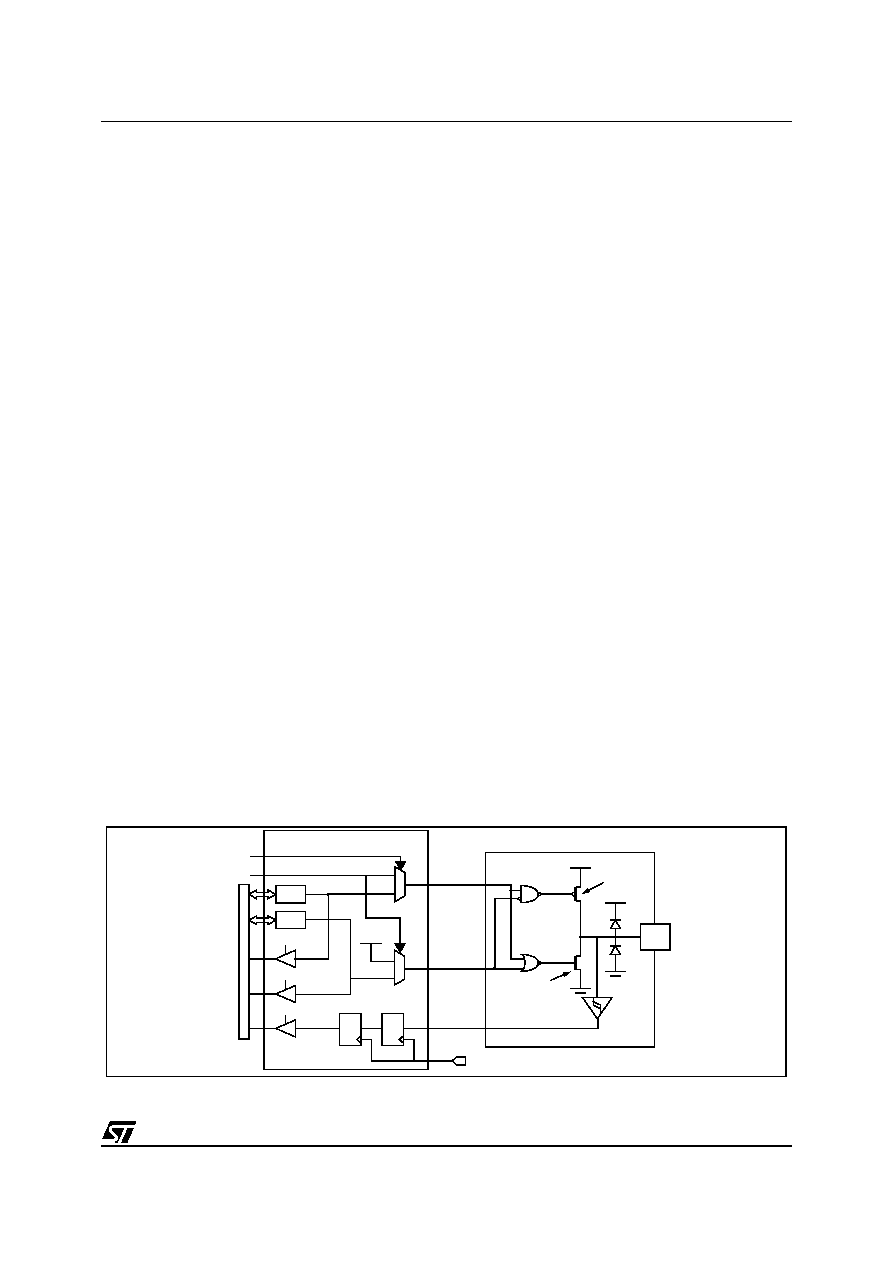- 您現(xiàn)在的位置:買賣IC網(wǎng) > PDF目錄98145 > ST7267R8T1L/XXX (STMICROELECTRONICS) 16-BIT, MROM, 30 MHz, RISC MICROCONTROLLER, PQFP64 PDF資料下載
參數(shù)資料
| 型號(hào): | ST7267R8T1L/XXX |
| 廠商: | STMICROELECTRONICS |
| 元件分類: | 微控制器/微處理器 |
| 英文描述: | 16-BIT, MROM, 30 MHz, RISC MICROCONTROLLER, PQFP64 |
| 封裝: | 10 X 10 MM, LEAD FREE, TQFP-64 |
| 文件頁(yè)數(shù): | 28/189頁(yè) |
| 文件大小: | 1643K |
| 代理商: | ST7267R8T1L/XXX |
第1頁(yè)第2頁(yè)第3頁(yè)第4頁(yè)第5頁(yè)第6頁(yè)第7頁(yè)第8頁(yè)第9頁(yè)第10頁(yè)第11頁(yè)第12頁(yè)第13頁(yè)第14頁(yè)第15頁(yè)第16頁(yè)第17頁(yè)第18頁(yè)第19頁(yè)第20頁(yè)第21頁(yè)第22頁(yè)第23頁(yè)第24頁(yè)第25頁(yè)第26頁(yè)第27頁(yè)當(dāng)前第28頁(yè)第29頁(yè)第30頁(yè)第31頁(yè)第32頁(yè)第33頁(yè)第34頁(yè)第35頁(yè)第36頁(yè)第37頁(yè)第38頁(yè)第39頁(yè)第40頁(yè)第41頁(yè)第42頁(yè)第43頁(yè)第44頁(yè)第45頁(yè)第46頁(yè)第47頁(yè)第48頁(yè)第49頁(yè)第50頁(yè)第51頁(yè)第52頁(yè)第53頁(yè)第54頁(yè)第55頁(yè)第56頁(yè)第57頁(yè)第58頁(yè)第59頁(yè)第60頁(yè)第61頁(yè)第62頁(yè)第63頁(yè)第64頁(yè)第65頁(yè)第66頁(yè)第67頁(yè)第68頁(yè)第69頁(yè)第70頁(yè)第71頁(yè)第72頁(yè)第73頁(yè)第74頁(yè)第75頁(yè)第76頁(yè)第77頁(yè)第78頁(yè)第79頁(yè)第80頁(yè)第81頁(yè)第82頁(yè)第83頁(yè)第84頁(yè)第85頁(yè)第86頁(yè)第87頁(yè)第88頁(yè)第89頁(yè)第90頁(yè)第91頁(yè)第92頁(yè)第93頁(yè)第94頁(yè)第95頁(yè)第96頁(yè)第97頁(yè)第98頁(yè)第99頁(yè)第100頁(yè)第101頁(yè)第102頁(yè)第103頁(yè)第104頁(yè)第105頁(yè)第106頁(yè)第107頁(yè)第108頁(yè)第109頁(yè)第110頁(yè)第111頁(yè)第112頁(yè)第113頁(yè)第114頁(yè)第115頁(yè)第116頁(yè)第117頁(yè)第118頁(yè)第119頁(yè)第120頁(yè)第121頁(yè)第122頁(yè)第123頁(yè)第124頁(yè)第125頁(yè)第126頁(yè)第127頁(yè)第128頁(yè)第129頁(yè)第130頁(yè)第131頁(yè)第132頁(yè)第133頁(yè)第134頁(yè)第135頁(yè)第136頁(yè)第137頁(yè)第138頁(yè)第139頁(yè)第140頁(yè)第141頁(yè)第142頁(yè)第143頁(yè)第144頁(yè)第145頁(yè)第146頁(yè)第147頁(yè)第148頁(yè)第149頁(yè)第150頁(yè)第151頁(yè)第152頁(yè)第153頁(yè)第154頁(yè)第155頁(yè)第156頁(yè)第157頁(yè)第158頁(yè)第159頁(yè)第160頁(yè)第161頁(yè)第162頁(yè)第163頁(yè)第164頁(yè)第165頁(yè)第166頁(yè)第167頁(yè)第168頁(yè)第169頁(yè)第170頁(yè)第171頁(yè)第172頁(yè)第173頁(yè)第174頁(yè)第175頁(yè)第176頁(yè)第177頁(yè)第178頁(yè)第179頁(yè)第180頁(yè)第181頁(yè)第182頁(yè)第183頁(yè)第184頁(yè)第185頁(yè)第186頁(yè)第187頁(yè)第188頁(yè)第189頁(yè)

ST7267C8 ST7267R8
123/189
15 MSCI I/O CONTROLLER
15.1 Introduction
The MSCI I/O ports can be configured in different
functional modes:
- data transfer through digital inputs and outputs
and for specific pins:
- alternate input/output signals for the parallel in-
terface.
Each of the two I/O ports contains 16 pins. Each
pin can be programmed independently as digital
input or digital output.
15.2 Functional Description
Each port has 3 main registers:
- Data Register Out (DRO)
- Data Register Input (DRI)
- Data Direction Register (DDR)
Each I/O pin may be programmed using the corre-
sponding register bits in the DDR register: bit X
corresponding to pin X of the port. The same cor-
respondence is used for the DRO and DRI regis-
ters.
The DRO and DDR registers can be read and writ-
ten by the MSCI core. The DRI register is an im-
age corresponding to the logic level on the I/OO
pin and can be read by the MSCI core (read only
register).
The MSCI I/O control block diagram is shown in
15.2.1 Input mode
The input configuration is selected by clearing the
corresponding DDR register bit. In this case, read-
ing the DRI register returns the digital value ap-
plied to the external I/O pin.
In this mode writing the DRO register has no effect
on the pad. However the values are written in the
DRO register and if the DDR register is set to out-
put mode, the value on the port will be the value
written previously in the DRO register.
15.2.2 Output mode
The output configuration is selected by setting the
corresponding DDR register bit. In this case, writ-
ing the DRO register applies this digital value to
the I/O pin through the latch.
In this mode reading the DRI register returns the
digital value applied to the external I/O pin.
15.2.3 Alternate functions
When an on-chip peripheral is configured to use a
pin in output mode, the alternate function is auto-
matically selected. This alternate function takes
priority over the standard I/O programming.
When the signal is coming from the parallel inter-
face, the I/O pin is automatically configured in out-
put mode when needed. There are two cases de-
pending of the type of signal:
- Control signals are configured using the CS bit in
the PCR2 register.
- Data signals are configured when the DIR bit in
the PCR1 register is set in output mode and data
transmission is on going.
When the signal is going to the parallel interface
(input mode), the I/O pin has to be configured in in-
put mode by the standard I/O programming to
avoid conflicts.
Figure 51. I/O Port General Block Diagram (When I/Os are dedicated to MSCI)
DRO
DDR
DA
TA
B
U
S
VDD
ALTERNATE
OUTPUT
1
0
DDR SEL
DRI SEL
PULL-UP
CONDITION
P-BUFFER
N-BUFFER
VDD
CMOS
SCHMITT
TRIGGER
DRO SEL
ALTERNATE
ENABLE
PAD
I/O
MSCI I/O Controller
MSCI CLOCK
1
0
VDD
相關(guān)PDF資料 |
PDF描述 |
|---|---|
| ST7267C8T1/XXX | 16-BIT, MROM, 30 MHz, RISC MICROCONTROLLER, PQFP48 |
| ST72774S9T1/XXX | 8-BIT, MROM, 8 MHz, MICROCONTROLLER, PQFP44 |
| ST72E734J6D0 | 8-BIT, UVPROM, 8 MHz, MICROCONTROLLER, CDIP42 |
| ST72T774S9T1 | 8-BIT, OTPROM, 8 MHz, MICROCONTROLLER, PQFP44 |
| ST7294C6B6 | 8-BIT, MROM, 4 MHz, MICROCONTROLLER, PDIP28 |
相關(guān)代理商/技術(shù)參數(shù) |
參數(shù)描述 |
|---|---|
| ST72681/R12 | 制造商:STMicroelectronics 功能描述:CONTROLLER FOR HIGH-PERFORMANCE BUS-POWERED USB 2.0 FLASH DR - Trays |
| ST72681/S13 | 制造商:STMicroelectronics 功能描述:CONTROLLER FOR HIGH-PERFORMANCE - Trays |
| ST7271 | 制造商:Panasonic Industrial Company 功能描述:IC |
| ST7271N5B1-CLF | 制造商:STMicroelectronics 功能描述: |
| ST727X4-EMU2B | 制造商:STMicroelectronics 功能描述:REALTIME EMULATOR BOARD - Bulk |
發(fā)布緊急采購(gòu),3分鐘左右您將得到回復(fù)。